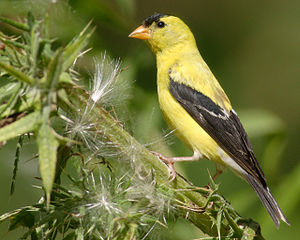 Summer
just seems to be flying. If you can believe it, some birds have
finished nesting and are already starting to fatten up in anticipation
of the journey south. As we approach August and September you will see
an increase in feeder activity.
Summer
just seems to be flying. If you can believe it, some birds have
finished nesting and are already starting to fatten up in anticipation
of the journey south. As we approach August and September you will see
an increase in feeder activity.Make sure to keep your feeders clean. It can be detrimental to the birds if you don’t clean your feeders regularly. In order to keep healthy birds at your feeders, remember the following:
 1. Feeders should be cleaned at least once a month. Wild Birds Unlimited
- East Lansing and Okemos- will clean your feeder for $5.00. Or you can
purchase professional cleaners like Scoot or Poop-Off at Wild Birds
Unlimited, or use a mild one part vinegar to nine parts water solution
to clean all of your feeders. Disassemble feeders and immerse them
completely for three minutes. Scrub with brushes (we have these too),
rinse thoroughly, and let air dry.
1. Feeders should be cleaned at least once a month. Wild Birds Unlimited
- East Lansing and Okemos- will clean your feeder for $5.00. Or you can
purchase professional cleaners like Scoot or Poop-Off at Wild Birds
Unlimited, or use a mild one part vinegar to nine parts water solution
to clean all of your feeders. Disassemble feeders and immerse them
completely for three minutes. Scrub with brushes (we have these too),
rinse thoroughly, and let air dry.2. Check your feeders after a rain to make sure the seed is dry. If not, replace it.
3. Use Feeder Fresh to keep your seed dry in humid weather.
4. Store seed in a cool dry location. Wild Birds Unlimited has closed steel containers that work well to protect seed from unwanted seed thieves or bad weather.
5. When choosing a new feeder look for something easy to clean and fill.
Also right now there are still young birds around learning the ropes and unfortunately, many times it's the inexperienced birds that fall victim to window strikes. Birds also strike windows as they quickly try to escape predators, hitting glass in a moment of panic. And during spring and fall migration, window strikes increase as birds unfamiliar with the area pass through your yard. Window strikes are hard to eliminate totally, but there are ways to reduce them and/or reduce their severity:
.

4. Store seed in a cool dry location. Wild Birds Unlimited has closed steel containers that work well to protect seed from unwanted seed thieves or bad weather.
5. When choosing a new feeder look for something easy to clean and fill.
Also right now there are still young birds around learning the ropes and unfortunately, many times it's the inexperienced birds that fall victim to window strikes. Birds also strike windows as they quickly try to escape predators, hitting glass in a moment of panic. And during spring and fall migration, window strikes increase as birds unfamiliar with the area pass through your yard. Window strikes are hard to eliminate totally, but there are ways to reduce them and/or reduce their severity:
.

1. Locate feeders and birdbaths within 1-2 feet of
windows so birds can't gather enough speed to cause significant injury
or about 20-30 feet from windows so birds have time to change direction.
2.Window feeders also alert birds to a window.
3. Window screens will reduce injury even if a bird flies into it. Use them where practical.
4. Decals like Window Alert placed on the outside of windows have had the most positive feedback from customers. Each decal contains a component which brilliantly reflects ultraviolet sunlight. This ultraviolet light is invisible to humans, but glows like a stoplight for birds.
3. Window screens will reduce injury even if a bird flies into it. Use them where practical.
4. Decals like Window Alert placed on the outside of windows have had the most positive feedback from customers. Each decal contains a component which brilliantly reflects ultraviolet sunlight. This ultraviolet light is invisible to humans, but glows like a stoplight for birds.
 According to Birds of Michigan
by Ted Black, “shrubby field edges, hedgerows, tangled riparian
thickets and abandoned, overgrown fields provide the elusive
Black-billed Cuckoo with its preferred nesting haunts. Despite not being
particularly rare in Michigan, it remains an enigma to many would-be
observers.
According to Birds of Michigan
by Ted Black, “shrubby field edges, hedgerows, tangled riparian
thickets and abandoned, overgrown fields provide the elusive
Black-billed Cuckoo with its preferred nesting haunts. Despite not being
particularly rare in Michigan, it remains an enigma to many would-be
observers. Similarly, “the
Similarly, “the 

 The
male goldfinch is a small, bright yellow finch with a black cap, wings,
and tail, and white rump and undertail coverts. Females are duller with
olive back and lacks black cap. Winter males will turn olive-brown with
yellow shoulder bars, white wing bars, dark bill, and may show black on
forehead and yellow on throat and face. Winter females are duller with
buff wings and shoulder bars, and lack yellow and black on face and
head. Juveniles resemble winter females but have a yellow wash on throat
and breast.
The
male goldfinch is a small, bright yellow finch with a black cap, wings,
and tail, and white rump and undertail coverts. Females are duller with
olive back and lacks black cap. Winter males will turn olive-brown with
yellow shoulder bars, white wing bars, dark bill, and may show black on
forehead and yellow on throat and face. Winter females are duller with
buff wings and shoulder bars, and lack yellow and black on face and
head. Juveniles resemble winter females but have a yellow wash on throat
and breast.
